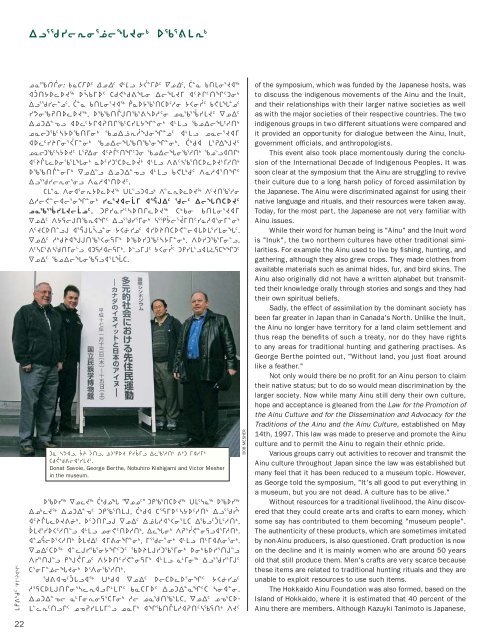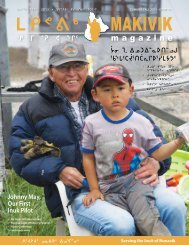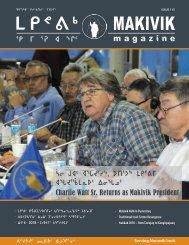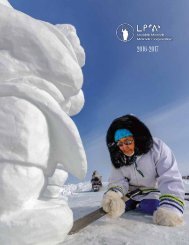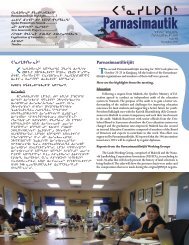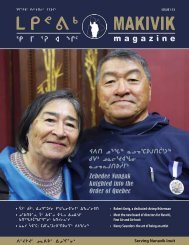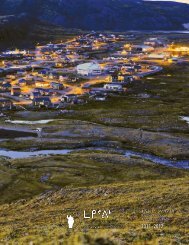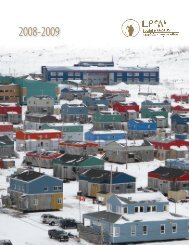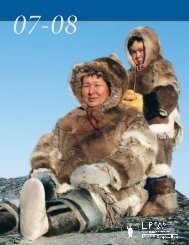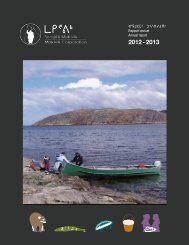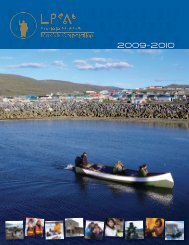Makivik Magazine Issue 72
You also want an ePaper? Increase the reach of your titles
YUMPU automatically turns print PDFs into web optimized ePapers that Google loves.
wl3dyoEi3ªozJi4 sc3[mE4<br />
mr[4f5 eu3Dxq5<br />
22<br />
kN3ctŒi: vNbus5 wkw5 x7ml IÙ8us5 Ékw5, Ì8N vtmi3Jx6<br />
x©tIsMsJ6 sñvus5 bf?4f[zi wozJu x5pQ5tq5gi4<br />
wl3dyo8k5. Ì8N vtmi3Jx6 ®NsIc3tbs5hi IXi¥5 v?mz8k5<br />
yKicDtsMsJ6, scctŒAtc3[nsh5i kNc3çymJ5 Ékw5<br />
wkgw8âl xsM5IQxDtQc5bymIq8i4 x7ml ckwoz5ht4<br />
kNogc5nIsctui4 ckw¬E§aiq8k5 x7ml kNo3Jxu<br />
xsM5ypQi3Ùu8i4 ckwozctc3iq8i4. Ì4fx m3DwaJ5<br />
kNogc5nIsJ5 m3Dwi x5pŒ5tq5gi ckwozic3ht4 ck9lxtQ4<br />
x5pŒZMsic3mzi4 Ns5yg3bsMsÔ4 x7ml W[5nc3tbsMsJ7uht4<br />
scctŒ8iu4 Ékw9l wkgw8âl x7ml v?m4f5 WNhx3tq5<br />
wl3dyoEi3il WNhx3tsJ5.<br />
bm8N Wix3iEIsMsJ6 Öm9lgxl4 W9MEsMsJ6 W5Jtc3hi<br />
who?9oxo3iq8i4 yM3Jxoµu x3ÇAw5 do5 woztbsJ5<br />
kNc3çymJoµk5. gryNy5nstQMsJ6 b4vi vtmi3Jxu<br />
Ékw5 WICoAtcExq5 wl3dy3ui4 n3e÷o3Ôut5yNhx3iu8i4<br />
W5Jbst9lA x3ÇAZñl8i IXîyk5 xysptbs?9oxZsZ3ymiz5.<br />
Ékw5 h4fpxaAtc3XiCu4 scsygc5nIu8i4, Wsygc3ui9l,<br />
W5nb3[ndtui9l xgChxoCu4. s9luj5 IXi¥5 grym9lxZ˜Cb1qg5<br />
Ékw5 ckwozicClx3m¯b.<br />
gˆ nKxl, ÷p Ítl, ªSesJ ryÏul wMc3ht4 [4g uxhu4<br />
bf¿4f[ox3ymJ5.<br />
Donat Savoie, George Berthe, Nobuhiro Kishigami and Victor Mesher<br />
in the museum.<br />
scsy6 ÉkMJ6 Ì4fkz >Ékk5> grc3tbsJ6 Öm5ãN6 scsy6<br />
wk4MJ6 wkgw8â5 grc3tmA, Ì4fx b3Cus5nIs5ht4 wl3d¥4<br />
x5pŒZMsJ[î4. s5gtQlA Ékw5 wªZhx3Xi3mb wcl5©m5ht4,<br />
ßmJ3ysX5ht9l x7ml ki?5tsht4, wMzi4 WD3¥?8iClx3uht4.<br />
x8kÇos3Xht4 ßmJw5 xu[iq8i4, u3do8i4 x7ml t7ux[i3i4.<br />
Ékw5bs6 x9MAyc3iIq5g5 cspmAygc3ui4 si4vsy3tA9l<br />
Wy3tA9l ra¿uk5 WIst5y?8iCu4 x7ml N7ui6 wl3dy3uA5<br />
b3iu8ªozJi4 s2Wic3ht4.<br />
d[xâ5©Zlx6 Ö4fx Ékw5 sobsMs3iq5 IXîyk5<br />
h3CbsmAtQi3nMExlQ7mQ5 vNbus5 wkgw8Nq5b nix8i.<br />
wkgw8âo N7uiEiC3bui4 ho kNdtc3mb, Ékw5 kâ3bsm9ME5tlQ5<br />
kâDymZu9l kNu4 xqctŒZhxDt5ncCt4 WJ5<br />
BOB MESHER<br />
of the symposium, which was funded by the Japanese hosts, was<br />
to discuss the indigenous movements of the Ainu and the Inuit,<br />
and their relationships with their larger native societies as well<br />
as with the major societies of their respective countries. The two<br />
indigenous groups in two different situations were compared and<br />
it provided an opportunity for dialogue between the Ainu, Inuit,<br />
government officials, and anthropologists.<br />
This event also took place momentously during the conclusion<br />
of the International Decade of Indigenous Peoples. It was<br />
soon clear at the symposium that the Ainu are struggling to revive<br />
their culture due to a long harsh policy of forced assimilation by<br />
the Japanese. The Ainu were discriminated against for using their<br />
native language and rituals, and their resources were taken away.<br />
Today, for the most part, the Japanese are not very familiar with<br />
Ainu issues.<br />
While their word for human being is "Ainu" and the Inuit word<br />
is "Inuk", the two northern cultures have other traditional similarities.<br />
For example the Ainu used to live by fishing, hunting, and<br />
gathering, although they also grew crops. They made clothes from<br />
available materials such as animal hides, fur, and bird skins. The<br />
Ainu also originally did not have a written alphabet but transmitted<br />
their knowledge orally through stories and songs and they had<br />
their own spiritual beliefs.<br />
Sadly, the effect of assimilation by the dominant society has<br />
been far greater in Japan than in Canada's North. Unlike the Inuit,<br />
the Ainu no longer have territory for a land claim settlement and<br />
thus reap the benefits of such a treaty, nor do they have rights<br />
to any areas for traditional hunting and gathering practises. As<br />
George Berthe pointed out, "Without land, you just float around<br />
like a feather."<br />
Not only would there be no profit for an Ainu person to claim<br />
their native status; but to do so would mean discrimination by the<br />
larger society. Now while many Ainu still deny their own culture,<br />
hope and acceptance is gleaned from the Law for the Promotion of<br />
the Ainu Culture and for the Dissemination and Advocacy for the<br />
Traditions of the Ainu and the Ainu Culture, established on May<br />
14th, 1997. This law was made to preserve and promote the Ainu<br />
culture and to permit the Ainu to regain their ethnic pride.<br />
Various groups carry out activities to recover and transmit the<br />
Ainu culture throughout Japan since the law was established but<br />
many feel that it has been reduced to a museum topic. However,<br />
as George told the symposium, "It's all good to put everything in<br />
a museum, but you are not dead. A culture has to be alive."<br />
Without resources for a traditional livelihood, the Ainu discovered<br />
that they could create arts and crafts to earn money, which<br />
some say has contributed to them becoming "museum people".<br />
The authenticity of these products, which are sometimes imitated<br />
by non-Ainu producers, is also questioned. Craft production is now<br />
on the decline and it is mainly women who are around 50 years<br />
old that still produce them. Men's crafts are very scarce because<br />
these items are related to traditional hunting rituals and they are<br />
unable to exploit resources to use such items.<br />
The Hokkaido Ainu Foundation was also formed, based on the<br />
Island of Hokkaido, where it is estimated that 40 percent of the<br />
Ainu there are members. Although Kazuyki Tanimoto is Japanese,


